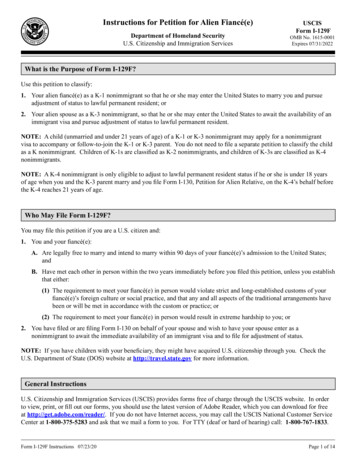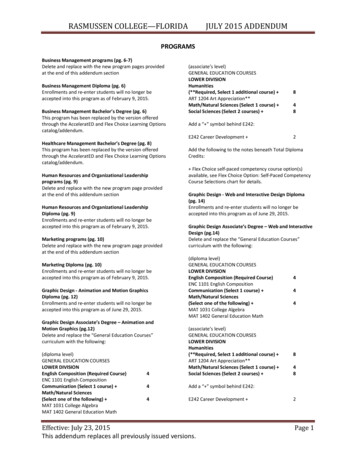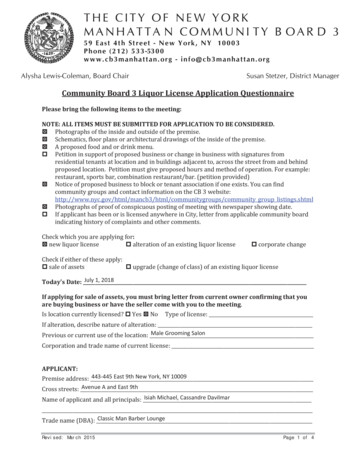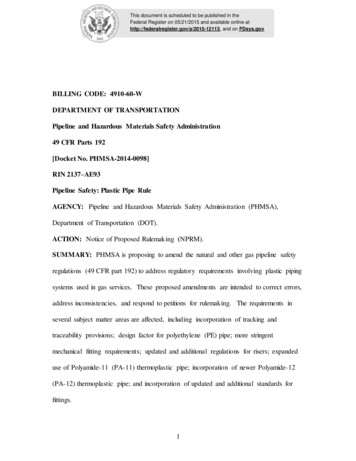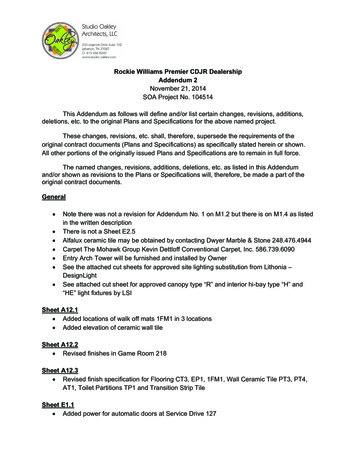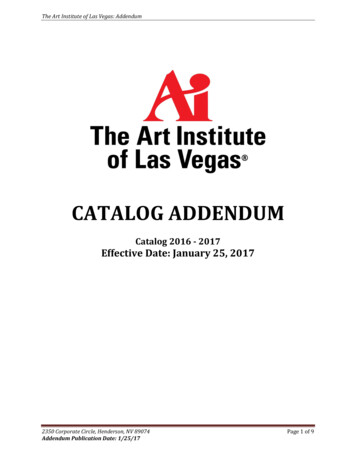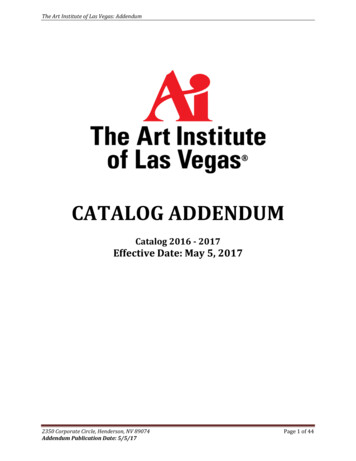
Transcription
ADDENDUM TO PETITION FOR A CONTESTED CASEThe following is the Addendum to Petition for Contested Case by the Bay Mills IndianCommunity. This Addendum is attached to and supplements the Petition for Contested CaseHearing form as completed and executed by the undersigned counsel.Petitioners:BAY MILLS INDIAN COMMUNITY12140 West Lakeshore DriveBrimley, MI 49715Attorneys for Petitioners:Kathryn TierneyBAY MILLS INDIAN COMMUNITYAttn: Legal Department12140 West Lakeshore DriveBrimley, MI 49715(906) 248-8100candyt@bmic.netDavid GoverNATIVE AMERICAN RIGHTS FUND1506 BroadwayBoulder, CO 80302(303) 447-8760dgover@narf.orgPermit / Application Numbers:Application Nos.HNY-NHX4-FSR2QPermit No.WRP0271791Adam RatchenskiDebbie ChizewerLaura BerglanEARTHJUSTICE311 S. Wacker Dr. Ste. 1400Chicago, IL 60606(312) 800- tice.orglberglan@earthjustice.orgStatement of Authority:This petition for a contested case hearing is initiated under the authority of the AdministrativeProcedures Act, 1969 PA 306, as amended, MCL §24.201 et seq. pursuant to the NaturalResources and Environmental Protection Act, 1994, PA 451, as amended, MCL §324.101 et seq.(“NREPA”) Parts 303 and 325 as well as the rules promulgated thereunder.1A copy of the Permit is attached to this Addendum as Exhibit 1.
INTRODUCTIONThe Bay Mills Indian Community (“Bay Mills”) petitions for a contested case hearing onWater Resources Permit WRP027179 (“Permit”), issued by the Michigan Department ofEnvironment, Great Lakes, and Energy’s (“EGLE”), on February 25, 2021, in violation of MCL324.30301, et seq., and EGLE’s own policies on tribal consultation and public participation. InWater Resources Permit WRP027179, EGLE authorizes Enbridge Energy, Limited Partnership(“Enbridge”) to construct a tunnel underneath the lakebed of the Straits of Mackinac and to theninstall a pipeline within the tunnel to transport light crude oil and liquid natural gas (the “TunnelProject,” or the “Project”). The existing dual pipelines that run along the lake bottom in theStraits would be decommissioned and a new pipeline would be routed through the tunnel. TheTunnel Project is a massive project that will cost more than 500 million dollars and take severalyears to complete.With this major Tunnel Project, Enbridge aims to continue transporting crude oil andnatural gas through its Line 5 pipeline across the Great Lakes for up to 99 years.2 Yet, thisproposed tunnel and continued operation of the Line 5 pipeline may soon become unnecessary:Governor Whitmer and the Michigan Department of Natural Resources have issued a notice ofrevocation and termination for Enbridge’s 1953 easement for the operation of the dual pipelinesin the Straits and have ordered a shutdown of the dual pipelines on May 13, 2021.3Nothing like this tunnel has ever been constructed in the Great Lakes and this Projectraises serious questions about the impact that the tunnel will have on the environment and2See Tunnel Agreement between Mackinac Straits Corridor Authority and Enbridge Energy,Limited Partnership, p. 34, Section 5.3 (December 19, el AgreementMCSA Enbridge Energy 684294 7.pdf.3Notice of Revocation and Termination of Easement, November 13, 2020.2
cultural and archaeological resources in the Straits area. The Project will involve boring a tunnelunderneath the Straits of Mackinac in the Great Lakes, which hold twenty percent of the world’sfresh surface water. The tunnel construction will require a massive disturbance of land andinvolve construction and the placement of structures on the bottomlands within the Straits,placing at risk the significant cultural and historic properties within the Straits of Mackinac area,including the bottomlands and the shore area.The Tunnel Project threatens Bay Mills’ way of life and its treaty-protected interests inthe Great Lakes, the Straits of Mackinac, and the surrounding areas. As described in thisAddendum to the Petition, the Straits area is a place of historic and ongoing cultural, spiritualand economic significance; it is where tribal members fish, gather plants for food and medicine,and pray. In an effort to protect these interests, Bay Mills has raised its concerns in the tunnelpermitting processes 4 by submitting detailed comments to EGLE,5 participating in consultationEGLE, and writing numerous letters to EGLE.Because Bay Mills views the Straits area and the cultural and historic properties locatedtherein as a single cohesive landscape, the destruction or contamination of one part of thelandscape damages the entire landscape. Bay Mills aims to prevent the destruction or degradationof cultural resource sites in the Straits area.Echoing Bay Mills’ and other Tribal Nations’ concerns about the risks the Project posesto this area of great cultural and historic significance, the State Historic Preservation Office4Bay Mills has also participated in the permitting processes for other state and federal permitsrequired for the Project, including permits before the United States Army Corps of Engineers andthe Michigan Public Service Commission.5See Bay Mills’ and Little River Band’s Comments on EGLE Application Nos. HNY-NHX4FSR2Q and HNY-TBJC-PNK8V, with attachments (October 19, 2020) (“Bay MillsComments”), Exhibit 2.3
(“SHPO”)—an agency with responsibility to preserve sites under federal and state law—recommended additional studies be completed to assess the Project’s impact on historical andcultural resources prior to the issuance of the Permit. However, EGLE sidelined the SHPO’s andBay Mills’ concerns and issued the Permit before the completion of these crucial studies.Despite the unique, complex, and substantial nature of the proposed undertaking, EGLEfailed to undertake critical steps required by law before issuing the Permit. This Addendum tothe Petition details Bay Mills’ interests in this permitting process, provides important factssurrounding the Project and the permitting process, and explains EGLE’s failure to follow thelaw and its own policies. First, EGLE blatantly disregarded the calls by experts—including theSHPO, a sister government agency, and Bay Mills and other Tribal Nations—for furtherarchaeological and cultural studies before making a decision on the permit application. Second,EGLE contravened its own policies by failing to conduct meaningful tribal consultation. Third,EGLE thwarted public participation by not allowing the public to review and comment oncritical documents and plans prepared after the comment period ended. Accordingly, Bay Millsrequests that the Permit be denied.PETITIONER’S RELATIONSHIP/INTEREST TO THE ACTIVITY ORPROPOSED PROJECT1. Petitioner, Bay Mills, a federally recognized Indian Tribe, requests a contested caseproceeding to represent the interests of its members in protecting treaty rights, natural resources,and cultural and historic resources from risk and harm associated with the activities authorizedby Water Resource Permit Number WRP027179, issued by EGLE on February 25, 2021.2. Gnoozhekaaning, “Place of the Pike,” or the Bay Mills Indian Community is afederally recognized Indian Tribe with a government organized under the provisions of theIndian Reorganization Act of 1934, 25 USC §5101.4
3. Bay Mills has 2,196 enrolled members and a service area that includes Chippewa,Mackinac, and Luce Counties. More than half of the enrolled members live on or near the BayMills Reservation.4. Bay Mills is a modern-day successor in interest to Indians who were signatories to theMarch 28, 1836 Treaty of Washington, 7 Stat. 491.5. In the Treaty of Washington, the Indian signatories ceded to the federal government14 million acres of land and inland waters and 13 million surface acres of water in LakesMichigan, Huron, and Superior; while reserving the right to hunt, fish, and other privileges ofoccupancy.66Treaty of March 28, 1836, 7 Stat 491. Bay Mills, Grand Traverse Band of Ottawa andChippewa Indians, Little Traverse Bay Bands of Odawa Indians, Sault Ste. Marie Tribe ofChippewa Indians, and Little River Band of Ottawa Indians are successors to the signatories ofthe 1836 Treaty and are collectively known as “the 1836 Treaty Tribes.”5
6. This area, pictured in the map below, is known as the “Ceded Territory.”7. The Affidavit of Bay Mills Indian Community President Whitney Gravelle, attachedas Exhibit 3 to this Petition, provides further information regarding Bay Mills; the role of itspredecessors-in-interest in the Treaty of Washington; the rights of Bay Mills arising out of theTreaty of Washington; and the role of Bay Mills in the landmark case affirming those treatyrights known as United States v. Michigan, 471 F Supp 192 (W.D. Mich. 1979).6
8. As an 1836 Treaty Tribe, Bay Mills retains usufructuary property rights to naturalresources in the Ceded Territory, including in and around the Straits of Mackinac. The State ofMichigan is obligated to honor these treaty-protected rights and is prohibited from diminishingthem.9. The Straits of Mackinac is a place of immense spiritual and cultural significance toBay Mills. According to oral histories, the creation of North America began with a floodedEarth. The animals that survived the flood received instructions from the Creator to swim deepbeneath the water and collect soil that would be used to recreate the world. All of the animalsfailed, but the body of the muskrat, the last animal that tried, resurfaced carrying a small handfulof wet soil in its paws.7 It is believed that the Creator used the soil collected and rubbed it on theGreat Turtle’s back, forming the land that became known as Turtle Island, the center of creationfor all of North America. According to the history, the Great Turtle emerged from the flood inthe Straits of Mackinac. The word “Mackinac” is derived from the original name of the GreatTurtle from the Ojibwe story of Creation.810. The area provides numerous spawning grounds for different fish species – includingLake Whitefish – which Bay Mills holds sacred. According to the Tribe’s oral histories, during atime of famine and desolation, the eight traditional clans Bear, Turtle, Deer, Loon, Crane,Marten, Bird, and Whitefish came together to discuss how to save the Anishinaabe throughoutthe Great Lakes region. After much debate and discussion, the Whitefish clan chose to sacrificeitself to provide for the wellbeing of the people. The Whitefish clan submerged itself in the GreatLakes and became the Whitefish that Tribal citizens harvest and eat today.78Bay Mills Comments, p. 24, Exhibit 2.Id.7
11. Since time immemorial, the robust ecosystem of the Great Lakes watershed hasallowed for trading and harvesting of many different traditional medicines and food sources.9Tribal citizens gather maple sugar, berries, mushrooms, and wild rice (manoomin) within theGreat Lakes watershed. These foods are staples to the traditional diets of Tribal citizens. Otherculturally important plant species are found in the watershed including Northern white cedar(giizhik), a plant considered sacred to Bay Mills, and black ash (aagimaak). These plant speciesare important for producing medicine, canoes, clothing, baskets, and ricing sticks for harvestingwild rice (manoomin).1012. Bay Mills Conservation Officers patrol the Ceded Territory – both by boat and byland.13. Due to its significant interest in the Straits of Mackinac and surrounding areas, BayMills has actively engaged in tribal consultation opportunities throughout the Tunnel Projectpermit processes, including the Water Resource Permit.1114. The proposed permit activity threatens harm or will adversely affect or impair theTreaty protected resources, including aquatic resources of both Lakes Huron and Michigan at the9Affidavit of Whitney B. Gravelle, Exhibit 3.Id.11Tribal consultation occurs on a government-to-government basis with the core objective ofmeaningful communication and collaboration on matters of shared concern. Exec. Dir. No. 201917, Tribal Relations (October 31, 2019); see also 2002 Government-to-Government AccordBetween the State of Michigan and the Federally Recognized Indian Tribes in the State ofMichigan, Lansing, Michigan, October 28, l 53478 7.pdf. Bay Mills was clear to EGLEthroughout the Permit process regarding its expectations surrounding tribal consultation. SeeLetter from President Bryan Newland to various agencies (August 18, 2020) “Bay Mills can askquestions and present concerns [and] agencies can provide responses.” Exhibit 4; Letter fromPresident Bryan Newland to Ms. Teresa Seidel, Director Water Resources Division, EGLE(January 28, 2021), Exhibit 5.108
Straits of Mackinac, and Bay Mills’ members use and enjoyment of those resources, wildlife,plants, and natural resources.15. The proposed project will adversely affect historical and cultural resources in andaround the Straits of Mackinac.16. Bay Mills submitted extensive comments to EGLE expressing its concerns andopposition to this Project.12 Bay Mills also sent multiple letters documenting its concerns aboutthe Project proceeding without further cultural and archaeological studies and an opportunity forthe public to comment on materials obtained by EGLE after the comment period.13OTHER PARTIES17. EGLE is the administrative agency responsible for the administration of theprotection of wetlands pursuant to Part 303 of the NREPA, MCL 324.30301 et seq., and is theadministrative agency responsible for the administration of the public trust bottomlands of theGreat Lakes and any permitting in the state of Michigan pursuant to Part 325 of the NREPA,MCL §324.32501 et seq.18. Enbridge applied for and was issued Water Resource Permit Number WRP027179.As a result, it is a potential party in this proceeding.12See Bay Mills Comments, Exhibit 2.See, e.g., Letter from President Bryan Newland, Bay Mills, et al, to Director Liesl Clark,EGLE (December 11, 2020), Exhibit 6; Letter from President Bryan Newland, Bay Mills, toDirector Liesl Clark, EGLE (January 21, 2021), Exhibit 7.139
STATEMENT OF MATTERS ASSERTED, INCLUDING THE SITE LOCATION ANDOTHER PERTINENT FACTS19. The Straits of Mackinac and the surrounding area have profound cultural significanceto Bay Mills.1420. The Straits of Mackinac area is replete with sites that are listed, or eligible for listing,on the National Register of Historic Places, a recognition that they are important to our nationalpatrimony.1521. Enbridge, including its predecessor(s) in interest, and its various related corporateentities, is in the business of transporting fossil fuels and operating pipeline infrastructure.1622. “Line 5” is the pipeline at issue in the Application. Line 5 is a 645-mile-long pipelinethat runs from Superior, Wisconsin to Sarnia, Ontario.1723. Line 5 is utilized primarily for the transport of light crude oil and natural gasliquids.1824. At the Straits of Mackinac, Line 5 splits into two 20” pipelines that extend along thelakebed of Lake Michigan (the “dual pipelines”).25. The dual pipelines were constructed in 1953; since that time, the dual pipelines havebecome aged, damaged, and the subject of multiple lawsuits.1914See Affidavit of Whitney B. Gravelle, Exhibit 3.See e.g., John M. O’Shea and Guy A. Meadows, “Evidence for early hunters beneath the GreatLakes,” PNAS, vol. 106 no. 25 (June 23, 2009); see generally, Charles E. Cleland, Rites ofConquest: The History and Culture of Michigan’s Native Americans. (University of MichiganPress) (1992); John Halsey, ed., Retrieving Michigan’s Buried Past (Cranbrook Institute ofScience) (1999).16See Enbridge, Inc. – About us, available at https://www.enbridge.com/about-us.17See Enbridge Liquid Pipeline Assets Map, available ture,crudeInfrastructure.18Id.19See, e.g., Attorney General v Enbridge, No. 19-474-CE (Ingham County Cir Ct, 2019);Enbridge Energy, Limited Partnership v. Whitmer et al., Case No. 1:20-cv-01141 (W.D. Mich.,1510
26. In order to maintain its preferred routing of Line 5 through the Straits of Mackinac,and in response to safety concerns, Enbridge proposed building a tunnel under the lakebed andreplacing the dual pipelines with one new 30” pipeline in the tunnel.20PROPOSED PROJECT AND APPLICATION PROCESSProject Overview27. On April 8, 2020, Enbridge submitted its Joint Permit Application,21 Submission No.HNY-NHX4-FSR2Q (“Joint Permit Application” or “Application”), for filling of wetlands, theplacement of structures on the bottomlands of the Great Lakes, and construction activities withinthe 100-year floodplain of the Great Lakes to EGLE and the Army Corps.22 EGLE and the ArmyCorps conduct independent permit reviews, but their review processes are based on the sameJoint Permit Application, amendments to the application, supporting materials, and overlappinganalysis of statutory considerations. The Army Corps may not issue a permit unless and untilEGLE issues the Permit.Nov. 24, 2020); State of Michigan, et al. v. Enbridge Energy, Limited Partnership, Case No.1:20-cv-01142 (W.D. Mich., Nov. 24, 2020).20Aside from the permit at issue in this Petition for a Contested Case, the Project requires severaldistinct permit approvals, including but not limited to (1) a permit from the Army Corps ofEngineers for dredging and filling wetlands under Section 404 of the Clean Water Act; (2) aNational Pollution Discharge Elimination System permit under Part 31 of NREPA and Section402 of the Clean Water Act; and (3) approval from the Michigan Public Service Commissionunder Act 16 for construction of the tunnel and re-routing of the dual pipelines.21The EGLE/Army Corps Joint Permit Application covers permit requirements derived fromstate and federal rules and regulations for construction activities where land meets the water. Itprevents duplication of state and federal permitting and provides for simultaneous review foractivities involving wetlands, floodplains, dams, inland lakes and streams, Great Lakesbottomlands, critical dunes, environmental areas, and high-risk erosion areas.22The EGLE application documents are publicly available in the “MiWaters” database 869251480183093/documents.11
28. The site of the proposed Project includes Emmet County, Wawatam Township,T39N-R04W-Section 10, Mackinac County, Moran Township, T40N-R04W-Section 23, and theStraits of Mackinac, which connects Lake Michigan and Lake Huron.2329. The Project will involve the filling and disturbance of wetlands and significantdisturbance, including drilling, blasting, and excavation, of other land.2430. The proposed tunnel would be approximately 3.58 miles long and 18-21 feet indiameter, connecting Point LaBarbe in Michigan’s Upper Peninsula to McGulpin Point inMichigan’s Lower Peninsula.2531. The proposed tunnel would be constructed using a tunnel boring machine.2632. A launch portal would be constructed in the southern work area to provide for thetunnel boring machine’s entry at McGulpin Point. This portal would be approximately 60 feetwide, up to 1,000 feet long, and 75 feet deep.2733. A circular shaft would be constructed on the northern side, Point LaBarbe, for thetunnel boring machine’s exit. This shaft would be approximately 70 feet in diameter andapproximately 150 feet deep.2834. As explained in Enbridge’s Joint Permit Application materials, Enbridge plans toremove approximately 364,000 cubic yards of material from underneath the lakebed to constructthe tunnel.2923Permit, p. 1.Joint Permit Application, p. 101.25Joint Permit Application, p. 9.26Id. at 99.27Id. at 101.28Id. at 101.29Army Corps of Engineers, Public Notice Re Enbridge Energy, LP No. LRE-2010-00463-56A19, p. 2 (“Corps Public Notice”) (May 15, 2020), Exhibit 8.2412
35. The Project would also involve widening an existing road, Boulevard Drive, and thefilling of a wetland to provide a construction and staging area on the northern work area.36. Enbridge’s Joint Permit Application includes decommissioning of the existingpipelines, stating that “[o]nce the new segment of the pipeline across the Straits is put intoservice, the existing dual pipelines will be decommissioned in accordance with federal, state, andlocal regulations ”3037. On April 14, 2020, the Army Corps sent a letter to Enbridge requiring substantial,additional information about the Project including details of the tunnel design, informationrelated to wetland impacts, and decommissioning.31 The Army Corps indicated that Enbridge’spermit application would not be deemed complete unless the information was submitted.38. On May 4, 2020, in response to the Army Corps’ information request, Enbridgeprovided two options for decommissioning the pipelines.3239. The first option was “Abandonment in Place of Dual Pipelines.” Under this option,Enbridge would leave all 21,000 feet of each pipeline in place. This would entail purging andcleaning the pipelines and plugging/grouting the ends.3340. The second option was “Removal of Unburied/Exposed Sections of the DualPipelines.” Under this option, Enbridge would remove those portions of the pipelines that arefully or partially exposed and not fully buried along the shoreline. This option would entail: (1)purging/cleaning the pipelines; (2) removing all screw anchor supports or cutting them near the30See Joint Permit Application, p. 103.Letter from Kerrie Kuhne, Chief, Permit Evaluation Western Branch, U.S. Army Corps ofEngineers to Paul Turner, Environmental Specialist, Enbridge (April 14, 2020), Exhibit 9.32Letter from Paul Turner, Environmental Specialist, Enbridge, to Kerrie Kuhne, U.S. ArmyCorps of Engineers, p. 5 (May 4, 2020), Exhibit 10.33Id.3113
mudline; (3) “jet sledding,” the partially covered portions of the pipelines and anchor supports toremove sediment to allow for cutting and removal; (4) cutting the pipelines into segments; (5)capping the ends of the remaining, buried portions of the pipelines; (6) winching the pipelinessegments of pipe that are closer to the shoreline of the Straits and cutting them into lengthssuitable for transportation; (7) cleaning and transporting the pipeline segments off-site; and (8)monitoring the remaining sections of the pipelines.3441. Enbridge noted that decommissioning by Removal of Unburied/Exposed Sections ofthe Dual Pipelines “would be expected to require approvals” from EGLE, other state agencies,and the Army Corps.3542. Also on May 4, 2020, EGLE sent Enbridge a Correction Request stating that theApplication was “incomplete as received” and could not be further processed without the receiptof additional information.3643. On June 23, 2020, Enbridge submitted a revised Application.37 While it is titledSubmission No. HNY-NHX4-FSR2Q, version 4, the only previous version publicly available onEGLE’s website is version 1.44. On July 21, 2020, Enbridge submitted version 5 of its Application.38EGLE’S Public Comment and Review Process45. EGLE published the public notice for the Joint Permit Application on July 31, 2020.The public notice provided for the submission of written comments by October 19, 2020.3934Id.Id. at 6.36EGLE, Correction Request to Enbridge regarding Submission no. HNY-NHX4-FSR2Q (May4, 2020), Exhibit 11.37Submission No. HNY-NHX4-FSR2Q, version 4.38Submission No. HNY-NHX4-FSR2Q, version 5.39EGLE Public Notice regarding Submission No. HNY-NHX4-FSR2Q (July 31, 2020).3514
46. As detailed below, EGLE continued to request and accept critical information fromEnbridge after the close of the public comment period on October 19, 2020. The public commentperiod was not re-opened to allow for the review of materials that EGLE relied on as part of itsdecision making.47. On October 20, 2020, EGLE sought information from McMillen Jacobs Associates, aprivate engineering firm, regarding the Project. McMillen Jacobs Associates provided multiple“whitepapers” addressing particular topics, upon which EGLE relied for its permit review. Thesedocuments were not disclosed much less made available to the public or the consulting TribalNations until the date the permit documents were published on January 29, 2021.4048. On November 17, 2020, EGLE requested critical information from Enbridge on avariety of topics including cultural, historic, and archaeological resources, wetland impacts,mitigation of wetland impacts, impacts to threatened and endangered species, anddecommissioning of the existing pipelines.4149. Regarding decommissioning, EGLE specifically requested “a conceptual plan andtimeline for decommissioning and removal of the existing twin pipelines through the straits.”4250. On December 18, 2020, Enbridge responded to EGLE’s information request aboutdecommissioning by referring EGLE to Enbridge’s May 4, 2020, response to the Army Corps. Itdid not provide any additional information about decommissioning.4340McMillen Jacobs Associates white papers are available 16---,00.html.41Email from Joseph Haas, District Supervisor, EGLE, to Paul Turner and Peter Holran,Enbridge (November 17, 2020), Exhibit 12.42Id.43Letter from Paul Turner, Environmental Specialist, Enbridge, to Joseph Haas, DistrictSupervisor, EGLE (December 18, 2020), Exhibit 13.15
51. With regard to the Native American burial mound (20MK15) located on the northside of the Straits in close proximity to the proposed placement of the outfalls in the Project area,Enbridge’s December 18 response claimed—without support—that the SHPO records suggestthat the burial mound has been destroyed.44Enbridge’s Limited Cultural Resource Studies52. As part of its Joint Permit Application, Enbridge incorporated reports, including pastcultural surveys, prepared for different purposes. For instance, Enbridge submitted a CulturalResource Survey of the Straits created in a related permitting process designed to obtainpermission to conduct geotechnical investigations—including borings—that informed the tunneldesign. This limited Cultural Resource Survey relied on a “Desktop Assessment,” conducted forarchaeological review by SEARCH, Inc., which assessed previously collected side-scan sonarimagery and identified 32 acoustic contacts (features) near the Project area.45 The “DesktopAssessment” reached the unlikely conclusion that “[n]one of the 32 contacts are likely torepresent a submerged cultural resource.”4653. On February 12, 2020, new information concerning the reliability of the SEARCHreport was revealed. An expert archaeologist, Dr. John M. O’Shea, sent a letter to the DeputyState Historic Preservation Officer and shared information he received from a technician—awhistleblower—who had been involved with the inadequate Survey.4744Id.SEARCH, Maritime Archaeology Desktop Assessment in Support of the Enbridge Line 5Geotechnical Surveys Project, Emmet and Mackinac Counties, Michigan, (Feb. 2019), at 30.46Id. at 30-31.47Letter from Professor John M. O’Shea, Curator of Great Lakes Archaeology, to Ms.MacFarlane-Faes, Deputy State Historic Preservation Officer (February 12, 2020), Exhibit 14.4516
54. Dr. O’Shea’s letter relayed information from the technician whistleblower:No new survey was conducted, but instead the assessment was based on sonarimagery previously conducted for other purposes. The technician assigned tothe job was told only to consider shipwrecks. This is despite the now wellestablished fact that there are significant prehistoric remains dating 10,0008,000 BP on the lake bottom associated with the Lake Stanley/Chippewalowstands and that the river that would have connected the Huron and Michiganbasins at that point would be a prime location for prehistoric use. When thetechnician noticed linear stone alignments of the type documented in LakeHuron, he was told to ignore them. When he asked permission to consult withme about their potential cultural origin his request was again denied. He wassubsequently removed from the project and was not allowed to see the finalreport.4855. As part of its Joint Permit Application, Enbridge also submitted a Phase I CulturalResources Survey.49 That preliminary report acknowledged “nine previously recorded terrestrialcultural resources” within a one-mile radius of the dual pipelines in the Straits of Mackinac, andit noted that there were three unverified sites that may cross into the project areas and areassociated with tribal cultural traditions. The Phase I Report specifically mentions the possibilityof a Native American burial ground (designated as site 20MK15) at Point La Barbe, within onemile of the North Straits Project area: “The SHPO record, which is based on historicaldocumentation, indicates the site was the location of a precontact (likely Woodland period)Native American burial mound.”50 The Phase I Report also makes clear that there are likelyadditional sites, necessitating further study.56. More recently, Enbridge has taken on additional, non-expert cultural survey workwithout informing or engaging the permitting authorities. In a December 14, 2020 letter, acompany named Dirt Divers notified Bay Mills that it was preparing a “Cultural Resource48Id.Commonwealth Heritage Group, Phase I Cultural Resources Survey for the EnbridgeMackinac Straits Project, 20-22 (August 2019).4950Id.17
Survey” as part of the Great Lakes Tunnel Project, and it would be “reaching out and speakingwith your elders and community members about historic traditional use and existing use areas inand around the Straits.”51 None of the agencies involved in the review of the permitapplications—EGLE, the SHPO, or the Army Corps—were notified by Enbridge of this effort.No approvals were sought for this survey.57. On January 5, 2021, in response to Dirt Divers’ outreach, Bay Mills notified DirtDivers that it was denying permission to speak with its Tribal Historic Preservation Officer ortribal citizens or community members.52
This petition for a contested case hearing is initiated under the authority of the Administrative Procedures Act, 1969 PA 306, as amended, MCL §24.201 et seq. pursuant to the Natural Resources and Environmental Prote
